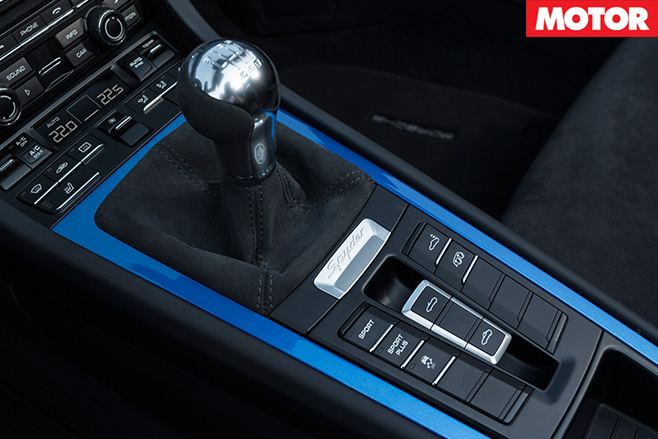Following hot on the heels of the limited-edition Cayman GT4, the Boxster Spyder is among the last of the current-generation mid-engined Porsche family.
But if you think the Spyder is simply a soft-top Cayman GT4 think again, for while the latter fuses elements of Carrera and GT3 into the smaller Cayman shell, the Spyder merely tweaks the DNA of the Boxster GTS, a car $23,500 cheaper and a phenomenal steer in its own right.
Unlike its hard-top GT4 sibling, the top-of-the-tree Boxster isn’t a product of Porsche’s motorsport department, though there is little separating the two in a straight line.

Combine this extra urge with a 1315kg kerb weight, the lightest of any Boxster, and 0-100km/h disappears in just 4.5sec on the way to a 290km/h top speed.
Key to that weight loss is the removal of the folding hard-top roof, replaced by a manually-operated bikini top which looks nice, can withstand an automatic car wash and remain in place at top whack, but requires the deft fingers of a surgeon to operate with any finesse.
Yes, it’s an improvement over the arrangement found on the previous-generation Boxster Spyder, but that will be of little comfort when every sudden weather change threatens to bring on a state of panic.

Another key difference between GTS and Spyder is the eagerness of the drivetrain. For maximum performance, keep it singing between 4500-7000rpm, where urge, thrust and throttle response are at their peak.
Being thankfully naturally-aspirated, it must work much harder than a turbo engine to muster up the power, but its response is more prompt, throttle modulation could hardly be sweeter and the engine note is a symphony.
The only available gearbox is a six-speed manual, but while the PDK would make it an easier day-to-day companion, the quick, slick manual is as good as they come.

Carbon ceramic stoppers are a hideously expensive option, and one of questionable value unless your driveway resembles the Nordschleife.
With the serpentine tarmac of the Swabian Albs as our playground, the Boxster Spyder reveals a first-class driving experience, with brakes designed in heaven, super sensitive touchy-feely steering and a chassis that fuses grip, traction and roadholding with five-star finesse.
At the limits of adhesion the ABS will momentarily decelerate the inside rear wheel to quell understeer and pull the nose back in line, even before the intervention of PSM (Porsche-speak for ESP), however with the stability control disabled and those 420Nm turning the rear tyres, the mechanical locking differential ensures the Spyder is every bit as capable with opposite lock applied as its more hardcore brethren.

Inside, the driving environment is more familiar, though with added dashes of alcantara and colour on the centre console and dash. Tech heads will find the sea-of-buttons infotainment and heating controls somewhat antiquated, but the driving position is peerless with superbly supportive seats (single-piece buckets are optional).
Overseas the Spyder presents itself as a pared-back, no-frills retro-racer, however Australian cars come fully loaded with satellite navigation, dual-zone climate control, cruise control, heated seats and the higher grade stereo system all standard.
Thus equipped, given the extra performance on offer the $23,500 premium charged over the Boxster GTS begins to take on less relevance.
That said, the Boxster Spyder won’t be to everyone’s taste. It doesn’t have the poise, panache or motorsport-derived credibility of the Cayman GT4, and the compromised roof arrangement makes life harder than it needs to be, limiting the car essentially to a sunny day plaything for most.

But pragmatism be damned, the retro-infused Spyder is an incredibly special car, a purist’s driving machine, the very existence of which should be celebrated for as long as possible.
With the imminent arrival of turbocharging, the next-generation of Porsche’s sports car range will offer a different experience. Whether or not Weissach’s engineers will continue on their current gold run is a question for the future, but for the moment, the hits just keep on coming.





